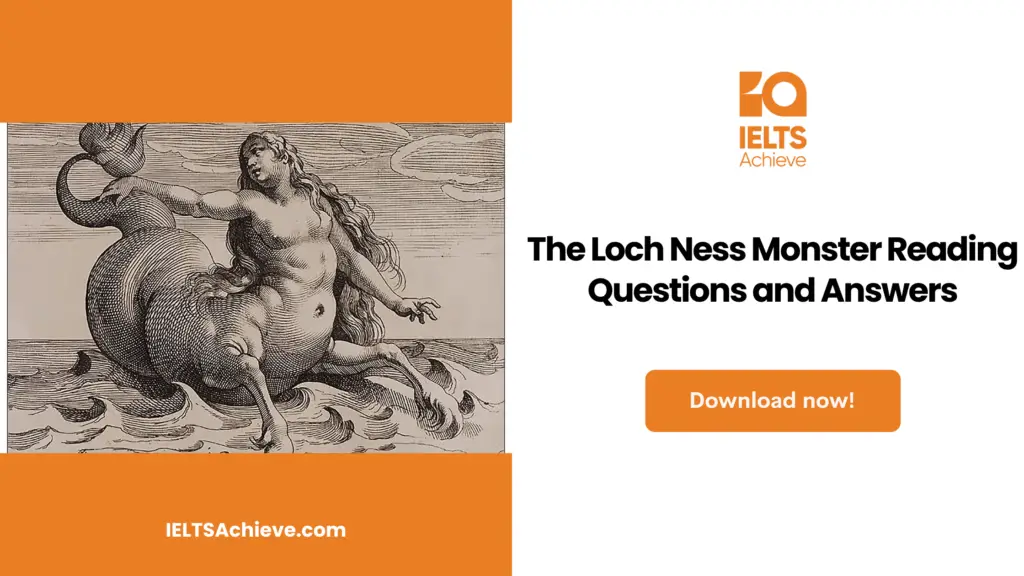The Blog post contains the following IELTS Reading Questions:
- IELTS Reading Short Answer Questions
- IELTS Reading True/False/Not Given
- IELTS Reading Multiple Choice Questions
Stay informed and prepared for success – Explore our comprehensive Reading Test Info page to get valuable insights, exam format details, and expert tips for mastering the IELTS Reading section.
IELTS reading passage – The Loch Ness Monster

The Loch Ness Monster
There is a widespread belief in the Scottish Highlands that a terrifying creature by the name of Nessie lives in the waters of Loch Ness. The waters of Loch Ness are the largest and longest freshwater body in the United Kingdom, measuring 24 miles in length. One mile is its width. Despite the fact that many skeptics believe it to be nothing more than a modern-day myth, other witnesses, who claim to have seen the monster, maintain that it exists and might still be located in the waterways of Loch Ness today.
Numerous Scottish lakes have been the subject of research, but Loch Ness is seen to be the most significant one in terms of the presence of monsters, with the lovably nicknamed “Nessie” being the most well-known of them all. Numerous individuals, both professionals and amateurs, travel to this lakefront with their cameras in the hopes of spotting the Loch Ness monster, also referred to as Nessie, and perhaps figuring out the mystery surrounding the monster.
The first recorded sighting of the fabled Loch Ness monster occurred in the year 565 A.D. Since she is claimed to have sunk herself after swallowing a farmer and before returning to the river, there have been no reports of her being seen again for more than a century. Nevertheless, several additional people have claimed to have seen her since the turn of the 20th century. Some people think that the ancient Scottish legend about water monsters like kelpies and water horses served as inspiration for the idea of a majestic creature hidden beneath the tills. These people believe that these myths played a part in the development of the until concept.
Nessie was last spotted in 2007, according to reports. A visitor from Yorkshire named Gordon Holmes claimed to have seen her and captured a video of her in the waters of Loch Ness. She was about 15 meters long, all black, and traveling at a speed of about 6 miles per hour down an incredibly straight path. Despite the alleged proof, there is still strong dispute and conflicting views on whether it exists. Others contend that the image taken by Holmes may be something other than a tree stump or perhaps one of the loch-dwelling otters, and that the video clip has been disregarded due to claims that it was tampered with.
Some scientists believe that the Loch Ness monster is simply a psychological phenomenon or a mirage since our perceptions are frequently shaped by our expectations. Of course, those who claim to have seen her will contest this, but a tremendous deal of research has been done to create theories that try to explain what it is that people might be seeing. A prehistoric creature known as a Plesiosaur, which had a maximum length of ten meters but is otherwise assumed to be extinct, may be related to Nessie, according to one idea. Although there is no evidence to back up this claim, it has been proposed that Nessie may be linked to this animal. One scholar in particular has been studying the lake itself to discover more about the lake’s past. It would appear that a huge food source would be necessary for such a large animal to thrive in this lake. On the other hand, there would need to be an abundance of zooplankton for such a large number of fish to thrive. The only method to know how much of this material is in the water is to assess how much algae is present there. Scientists can first assess what kind of population can be supported by figuring out how deep sunshine can reach into the lake because algae can only exist in the presence of light. Despite the fact that the fish population was found to be substantially lower than it should have been, the conclusions reached were unclear.
An observational study that lasted ten years was conducted in the 1900s. Around that period, Nessie was reported twenty times a year on average. In the latter half of the 20th century, when pictures of a “flipper” became widely available, the phenomenon grew quickly. To learn more about the enigmatic monster, submarines were sent into Loch Ness (and now are actually run as tourist attractions). Another theory for why Nessie rose to the top of the waters, where she was more likely to be observed, was that the disturbance brought on by nearby road construction in the 1930s forced her to relocate to higher levels due to the amount of vibration that fell into the water. The Loch’s supposed geographic location on the Great Glen fault line, which was formed more than 400 million years ago, is another source of debate. According to some scientists, the resulting seismic activity in the lake may be responsible for the surface disturbances that people may mistake for Nessie.
It’s plausible that the Nessie legend is just that—a legend—given the abundance of digital cameras, webcams pointed at the lake, and other modern developments in recording technology. Up to this moment, there is no evidence either supporting the existence of the monster or providing compelling evidence against it. Due in part to the attention the film industry gave the area, it is projected that linked tourism brought in £6 million to the area in 2007. In any case, lodgings can be found around the Scottish Highlands that offer tours of the lake itself so that visitors can try to spot Nessie for themselves. According to estimates, associated tourism brought in £6 million to the area in 2007.
Unlock your full potential in the IELTS Reading section – Visit our IELTS Reading Practice Question Answer page now!
Recommended Questions:
Renewable Energy IELTS Reading Question with Answer
The Loch Ness Monster reading questions
Questions 1-6
Choose NO MORE THAN THREE WORDS AND/OR A NUMBER from the passage for each answer.
- When was the first sighting of Nessie recorded?
- What was Cordon Holmes suspected of doing with the video footage?
- What common animal could have been captured on camera and misinterpreted as proof of Nessie?
- Images of what initiated an increase in the number of Nessie fans?
- What can tourists expect to see Nessie travel in?
- What in recent years has encouraged tourist industry within Loch Ness region?
Questions 7-11
Do the following statements agree with the information given in the reading passage? In boxes 7-11 on your answer sheet, write
TRUE if the statement is true
FALSE if the statement is false
NOT GIVEN if the information is not given in the passage
7. The testing of algae in the loch demonstrated that the source of food was insufficient for Nessie to survive.
8. There are indications that the Loch Ness monster is associated with plesiosaurs.
9. The most recent witness to the Loch Ness Monster has a video evidence.
10. It is thought that the Loch Ness monster was influenced by other stories about sea creatures.
11. The first discovery of the Loch Ness monster is been reported in 1962.
Enhance your skills in identifying information as True, False, or Not Given. Click here to discover expert strategies and techniques for mastering this question type in the IELTS Reading section.
Questions 12 & 13
Choose the correct option from A to D
12. Whom did Nessie swallow when it was spotted for the first time?
A). Farmer
B). Carpenter
C). A local lady
D). None of the above
13. Where are the waters of Loch Ness situated?
A). Scotland
B). London
C). United Kingdom
D). South Africa
Ready to improve your performance in Multiple Choice Questions (MCQs)? Click here to access our comprehensive guide on how to tackle MCQs effectively in the IELTS Reading section.
Unlock your full potential in the IELTS Reading section – Visit our IELTS Reading Practice Question Answer page now!
Recommended Questions:
Renewable Energy IELTS Reading Question with Answer
The Loch Ness Monster Reading Answers
1. 565 A.D.
2. TAMPERING
3. OTTER
4. A FLIPPER
5. A SUBMARINE
6. THE MOVIE INDUSTRY
7. FALSE
8. FALSE
9. TRUE
10. TRUE
11. FALSE
12. A
13. C

We hope you found this post useful in helping you to study for the IELTS Test. If you have any questions please let us know in the comments below or on the Facebook page.
The best way to keep up to date with posts like this is to like us on Facebook, then follow us on Instagram and Pinterest. If you need help preparing for the IELTS Test, join the IELTS Achieve Academy and see how we can assist you to achieve your desired band score. We offer an essay correction service, mock exams and online courses.

